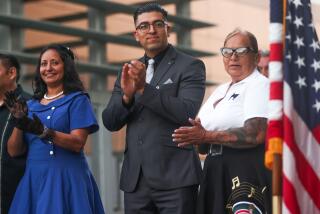Election Spending Revealed : Bitter Council Battle Was Also Compton’s Costliest
- Share via
COMPTON — The price of public office here apparently reached a record high last month, when City Councilman Floyd James spent $89,362--$11.54 per vote--to fend off a stiff challenge and win a third term.
City Clerk Charles Davis, a 12-year Compton official who doubles as elections chief, said this week that he can’t recall any candidate ever spending as much.
Fellow incumbent Councilman Robert Adams, who also won a third term, spent the next-highest amount--$63,564 or $8.84 per vote. And Davis said even that was far more than the “probably $24,000 to $25,000” that leading Compton council candidates have typically spent to gain the approval of voters.
What made this year’s election so pricey, Davis concluded, was “just politics. There were more people from the outside” with an interest in the results.
During the campaign, the two council incumbents were accused of catering to private developers who are reshaping the city. In turn, James and Adams accused their challengers of being too close to the political organization of Rep. Mervyn Dymally (D-Compton).
Financial Reports
The campaign figures for James, Adams and 10 other city government contenders were filed in a series of financial reports required by state law. The reports are intended to disclose what each candidate accepted in the way of contributions and then paid out in campaign expenses.
Seven remaining candidates--including newly reelected Mayor Walter Tucker--failed to meet the June 20 filing deadline and now face up to $100 in fines.
In a memo last week, Davis identified the tardy politicians and suggested that they be charged the maximum penalty. Ironically, the memo went to City Atty. Wesley Fenderson Jr., who is among the violators.
Tucker said this week that he plans to soon file his campaign report, showing that he spent “25 or 30 some odd thousand dollars.” Tucker’s main opponent, Councilman Maxcy Filer, said in his report that he spent $2,787.
Away at Conference
Fenderson was away at a national bar association conference in Chicago and is not expected to return until early next month, an assistant said.
“It is my understanding that upon his return,” said Legrand H. Clegg II, deputy city attorney, “he is going to immediately proceed to notify those persons who have been accused of being delinquent.”
“People get busy after elections,” Clegg explained. “It’s just negligence.”
Davis acknowledged that there is little precedent for making such filing fines stick. Although candidates in past elections have also missed disclosure deadlines, the clerk said he can’t recall anyone being forced to pay the penalty.
Not all of the financial reports on file prove to be that revealing. At least three losing candidates declared less than $500 in contributions, so they were not required to name individual donors.
But the reports for Adams, James and their opponents prove that the bitter battle over two council seats was costly, even when compared to such larger cities as Long Beach, where a $50,000 campaign is considered expensive.
At the center of the political debate was the presence of Dymally, who gave up his longtime support of the incumbents to back challengers Patricia A. Moore, a part-time Dymally aide, and Emily Hart-Holifield, a teacher.
“I never thought that an election in Compton would ever cost this much money,” said James, who finished second to Moore in the primary but won handily in the runoff. “But fortunately, when you have outside interference from a U.S. congressman trying to get control, there are enough people who care enough about the city who were willing to donate funds.”
Money From Developers
James’ major contributors, according to his report, included prominent Compton developers, such as Dalton Construction ($4,000), Watt Development ($7,000) and Afcom ($8,332).
Adams received $7,000 from Watt, $7,000 from Afcom and $8,326 from Afcom chairman Bill Dawson.
Afcom, based in Seal Beach, is working on several Compton construction ventures--most notably the once-blighted 63-acre Park Village housing development--that have required the City Council’s blessing, company president Sonia Sonju said.
“Both Councilman James and Councilman Adams were really responsible for approval of plans to develop that area,” Sonju explained. “Not everyone can visualize a sow’s ear turning into a silk purse.”
James’ opponent, Moore, spent $34,023 on her unsuccessful campaign, according to her financial report. The largest contributions included $10,000 in loans from Dymally and his campaign organization, plus several donations of $100 to $500 from an assortment of local labor unions. Dalton Construction gave Moore $500.
Adams’ opponent, Hart-Holifield, reported campaign expenses of $19,860. She also polled more votes than Adams in the primary, but lost in the runoff. Her post-election report did not reflect any contributions from Dymally.
Denies Influence
James said he won’t be influenced by the large developer donations, but that raising big money this year was a necessity. Because of Dymally’s involvement, he said, “we had to really get out there and talk to the people through the mail.”
One last-minute mailing by James has prompted a lawsuit from Moore, who charges that the councilman inaccurately told voters she had been officially disqualified as a candidate. The suit, which seeks to void the election results and ban James from public office, is pending in Los Angeles Superior Court.
James’ $30,042 campaign deficit was also the largest reported by any candidate.
Adams listed a $10,100 deficit.
More to Read
Sign up for Essential California
The most important California stories and recommendations in your inbox every morning.
You may occasionally receive promotional content from the Los Angeles Times.











